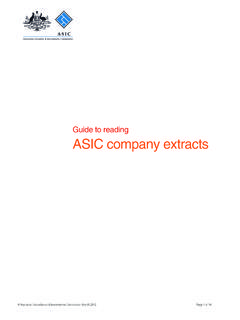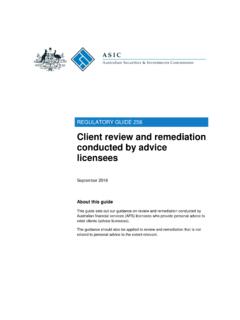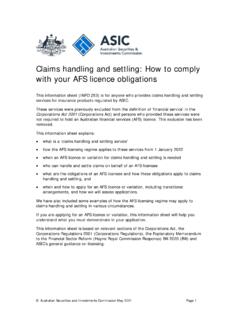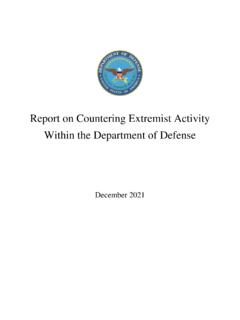Transcription of Regulatory Guide RG 78 Breach reporting by AFS licensees ...
1 Regulatory Guide 78 Breach reporting by AFS licensees and credit licensees September 2021 About this Guide This Guide is for Australian financial services (AFS) licensees and Australian credit licensees (credit licensees ). It gives guidance on your obligation to report to ASIC certain breaches of the law under Div 3 of Pt of the Corporations Act 2001 (Corporations Act) and Div 5 of Pt 2-2 of the National Consumer Credit Protection Act 2009 (National Credit Act). Note: This Guide does not cover certain reporting obligations: see RG Regulatory Guide 78: Breach reporting by AFS licensees and credit licensees Australian Securities and Investments Commission September 2021 Page 2 About ASIC Regulatory documents In administering legislation ASIC issues the following types of Regulatory documents. Consultation papers: seek feedback from stakeholders on matters ASIC is considering, such as proposed relief or proposed Regulatory guidance.
2 Regulatory guides: give guidance to regulated entities by: explaining when and how ASIC will exercise specific powers under legislation (primarily the Corporations Act) explaining how ASIC interprets the law describing the principles underlying ASIC s approach giving practical guidance ( describing the steps of a process such as applying for a licence or giving practical examples of how regulated entities may decide to meet their obligations). Information sheets: provide concise guidance on a specific process or compliance issue or an overview of detailed guidance. Reports: describe ASIC compliance or relief activity or the results of a research project. Document history This Guide was issued in September 2021 and is based on legislation and regulations as at the date of issue. Previous versions: Superseded Regulatory Guide 78, issued September 2008, reissued February 2014 and March 2020 Note: Superseded Regulatory Guide 78 (SRG 78), issued March 2020, is currently available on our website: see the link at the bottom of the RG 78 landing page.
3 Superseded Breach reporting by AFS licensees : An ASIC Guide , issued October 2004, reissued May 2006, and known in the ASIC Digest as [SGD 190]; rebadged as a Regulatory Guide 5 July 2007 Disclaimer This Guide does not constitute legal advice. We encourage you to seek your own professional advice to find out how the Corporations Act and other applicable laws apply to you, as it is your responsibility to determine your obligations. Examples in this Guide are purely for illustration; they are not exhaustive and are not intended to impose or imply particular rules or requirements. Regulatory Guide 78: Breach reporting by AFS licensees and credit licensees Australian Securities and Investments Commission September 2021 Page 3 Contents A Overview .. 4 Who this Guide applies to .. 4 What is the Breach reporting obligation?
4 4 Our approach to guidance .. 6 What this Guide does not cover .. 6 How our guidance applies .. 8 AFS licensees : Transitional provisions and the previous Breach reporting obligation .. 9 Credit licensees : reporting breaches that occurred before 1 October 2021 .. 10 B What you must report to 11 What is a reportable situation ? .. 11 What is a Breach or likely significant Breach of your core obligations? .. 14 What is a reportable investigation? .. 24 What are additional reportable situations? .. 30 Reportable situations about other licensees : Financial advisers and mortgage brokers .. 31 C When and how to report to ASIC .. 36 When must you report a reportable situation?.. 36 How do you report a reportable situation? .. 42 What will ASIC do after we receive your report ? .. 46 What are the consequences of failing to report to ASIC?
5 47 What information will ASIC publish? .. 48 D Compliance systems and identifying, recording and reporting breaches .. 49 What arrangements should you have in place for recording and reporting breaches? .. 49 Developing your approach to the Breach reporting obligation: Some practical insights .. 51 Do you need a Breach register? .. 53 Appendix: Summary of core obligations for licensees .. 54 What are the core obligations for AFS licensees ? .. 54 What are the core obligations for credit licensees ? .. 56 Bodies regulated by APRA .. 58 Key terms .. 59 Related information .. 63 Regulatory Guide 78: Breach reporting by AFS licensees and credit licensees Australian Securities and Investments Commission September 2021 Page 4 A Overview Key points If you are an Australian financial services (AFS) licensee or an Australian credit licensee (credit licensee), you must comply with your obligation to report certain breaches of the law to ASIC.
6 This Guide explains: what you must report to ASIC (see Section B); when and how you must report to ASIC, including information about how we deal with the reports we receive and the information we will publish about your reports (see Section C); and our expectations and guidance about your compliance systems (see Section D). Who this Guide applies to RG This guidance applies to AFS licensees and credit licensees and their representatives. Note: In this Guide , we refer collectively to AFS licensees and credit licensees as licensees . RG A Breach reporting obligation for credit licensees was introduced into Div 5 of Pt 2-2 of the National Consumer Credit Protection Act 2009 (National Credit Act) by the Financial Sector Reform (Hayne Royal Commission Response) Act 2020 (Financial Sector Reform Act). This obligation mirrors the Breach reporting obligation for AFS licensees in Subdiv B, Div 3, Pt of Ch 7 of the Corporations Act 2001 (Corporations Act) as reformed by the Financial Sector Reform Act.
7 Specific credit guidance is provided throughout this Guide where relevant. What is the Breach reporting obligation? RG The Breach reporting obligation requires licensees to self- report specified matters to ASIC. As stated in the Explanatory Memorandum to the Financial Sector Reform (Hayne Royal Commission Response) Bill 2020 (Explanatory Memorandum): Breach reporting is a cornerstone of Australia s financial services Regulatory structure. Breach reports allow ASIC to detect significant non-compliant behaviours early and take action where appropriate. It also allows ASIC to identify and address emerging trends of non-compliance in the industry. Note: See Explanatory Memorandum, paragraph Regulatory Guide 78: Breach reporting by AFS licensees and credit licensees Australian Securities and Investments Commission September 2021 Page 5 RG Early detection and reporting of misconduct and breaches of Regulatory requirements allow ASIC to: (a) monitor the extent and severity of non-compliance and commence surveillance and investigation when necessary; (b) take law enforcement and Regulatory action when warranted, including administrative action to protect consumers of financial products and services; and (c) identify and respond to emerging threats, harms and trends within the financial services industry, detect significant non-compliant behaviours early, and take the appropriate Regulatory response.
8 RG The Regulatory regime acknowledges that, despite an expectation of compliance, breaches will occur and licensees then have an obligation to report these to ASIC. licensees have a clear role in lifting industry standards as a whole, and part of this is timely identification of their own problems. RG We consider that a licensee s experience with incident and issues management, including breaches, should be a vital source of learning to both reinforce and improve an entity s compliance framework and overall function. Instances of non-compliance highlight a weakness to be understood, so improvements can be made to prevent the recurrence of the Breach in the future. RG Breach reporting has been identified as an important aspect of our Regulatory regime by: (a) the ASIC Enforcement Review Taskforce, which made several recommendations for strengthening and clarifying the Breach reporting requirements in the Corporations Act and recommended that a comparable Breach reporting regime for credit licensees be introduced (Recommendation 2); (b) the Royal Commission into Misconduct in the Banking, Superannuation and Financial Services Industry (Financial Services Royal Commission), which recommended that the Taskforce recommendations should be carried into effect (Recommendation ) and that serious compliance concerns be reported (Recommendations and ).
9 And (c) report 594 Review of selected financial services groups compliance with the Breach reporting obligation (REP 594), which sets out the findings of ASIC s review of AFS licensees compliance with their Breach reporting obligation under s912D of the Corporations Act. Note: See Treasury, ASIC enforcement review: Taskforce report , December 2017; Financial Services Royal Commission, final report , February 2019. Regulatory Guide 78: Breach reporting by AFS licensees and credit licensees Australian Securities and Investments Commission September 2021 Page 6 Our approach to guidance RG This Guide gives guidance on your obligation as a licensee to report to ASIC certain breaches of the law. We explain what information must be provided when reporting to ASIC, and what happens after you report , including what information we will publish as required by law.
10 By explaining how we deal with these Breach reports, we seek to enhance the transparency of our processes. RG To help you understand your obligations and how they might apply in different factual circumstances, this Guide contains a number of examples and historical case studies drawn from REP 594. These examples and case studies are for illustrative purposes only, and do not purport to limit the types of reportable situations that must be reported to ASIC or the reasons why a particular Breach may or may not be considered significant. RG Rather, we provide these examples and case studies to help provide clarity and promote the delivery of consistent and high-quality reports. Ultimately, it is your responsibility to decide whether you must report to ASIC under the law, taking into account the particular circumstances of your case.







